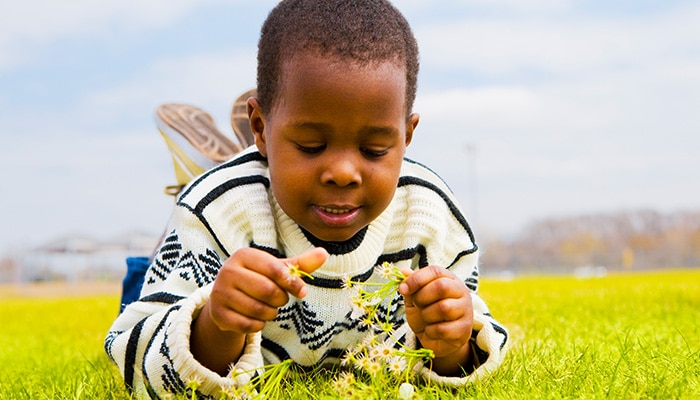While we believe that the books and resources recommended may be of value to you, keep in mind that these are suggestions only and you must do your own due diligence to determine whether the materials are appropriate and suitable for your use. PNC has no sponsorship or endorsement agreement with the authors or publishers of the materials listed.
OUTDOOR CLASSROOM

Nature Bracelets
Children will collect and investigate materials found in nature.

Lesson Objective
Children will make predictions and collect and investigate materials found in nature while taking a walk outside.
ScienceArt
What You'll Need
- Large, natural outdoor space for a walk
- Wide masking tape – 1 roll
- Magnifying glasses – 1 per child
What To Do
Note: This lesson requires a walk outside.
- Tell the children that they will be taking a walk outside to collect things found in nature (see Lesson Tips).
- Ask the children to make predictions about what they might find during this time of year (see Guiding Student Inquiry).
- Wrap masking tape around your own wrist with the sticky side out, show it to the children, and wrap their wrists.
- Tell them that as they find items, they can stick them to the tape on their wrists.
- Remind children that since this is a nature walk, they should only collect things found in nature. Ask if they should collect a leaf, some seeds, or grass? Then, ask “What about a candy wrapper?”
- Take the children outside.
- Encourage the children to collect a variety of objects such as leaves, grass, twigs, seeds, pieces of bark, small pebbles, flowers, etc.
- Continue to encourage the children to collect a variety of items during their walk.
- Upon returning to the classroom, distribute magnifying glasses.
- Have the children use the magnifying glasses to investigate and discuss the items they found (see Guiding Student Inquiry).
- Display the bracelets in the science area.
Resources
Home School Resources
Home educators: use these printable lesson PDFs to teach this lesson to your home schoolers. They're available in English and Spanish.
Content Provided By
Common Core State Standards Initiative – These lessons are aligned with the Common Core State Standards ("CCSS"). The CCSS provide a consistent, clear understanding of the concepts and skills children are expected to learn and guide teachers to provide their students with opportunities to gain these important skills and foundational knowledge [1]. Visit the CCSS


